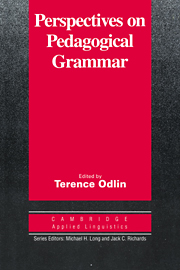Book contents
- Frontmatter
- Contents
- List of contributors
- Series editors' preface
- Preface
- Chapter 1 Introduction
- I WHAT SORT OF GRAMMAR?
- II GRAMMAR, LEXICON, AND DISCOURSE
- III PUTTING GRAMMAR TO WORK
- Chapter 9 The effect of systematic instruction on learning the English article system
- Chapter 10 Linguistic theory and pedagogic practice
- Chapter 11 The Introspective Hierarchy: A comparison of the intuitions of linguists, teachers, and learners
- Chapter 12 From printout to handout: Grammar and vocabulary teaching in the context of Data-driven Learning
- Chapter 13 Conclusion
- Glossary
- Index
Chapter 10 - Linguistic theory and pedagogic practice
Published online by Cambridge University Press: 05 October 2012
- Frontmatter
- Contents
- List of contributors
- Series editors' preface
- Preface
- Chapter 1 Introduction
- I WHAT SORT OF GRAMMAR?
- II GRAMMAR, LEXICON, AND DISCOURSE
- III PUTTING GRAMMAR TO WORK
- Chapter 9 The effect of systematic instruction on learning the English article system
- Chapter 10 Linguistic theory and pedagogic practice
- Chapter 11 The Introspective Hierarchy: A comparison of the intuitions of linguists, teachers, and learners
- Chapter 12 From printout to handout: Grammar and vocabulary teaching in the context of Data-driven Learning
- Chapter 13 Conclusion
- Glossary
- Index
Summary
Introduction
One of the major problems confronting language teachers, curriculum designers and materials writers is the selection and sequencing of grammatical content, the integrating of such content with semantic and pragmatic elements, and the selection of an appropriate pedagogy for curriculum implementation. In making choices about what to teach, when and in what way, practitioners can seek guidance from linguistic theory and research.
In this chapter, the implications of theoretical and empirical directions in linguistics for language pedagogy are presented and evaluated. I shall trace some of the major shifts which have occurred in theory and research since the 1960s and indicate ways in which these shifts have been reflected in pedagogic practice. The chapter will focus in particular on linguistic models which have made strong claims to relevance for pedagogy.
The empirical component of the paper takes the form of a case study of the grammatical teaching practices of two language teachers. The data base for the study consists of two classroom sequences in which the teachers are introducing and practising question forms – morphosyntactic items of particular significance to current second language acquisition theory. The implications of the research are presented and discussed.
Theoretical and empirical background
For much of this century, curriculum specialists looked to the contrastive hypothesis for guidance on the selection and sequencing of grammatical items for instruction (James 1980). This hypothesis is predicated on the assumption that a learner's first language will have a significant influence on the acquisition of a second.
- Type
- Chapter
- Information
- Perspectives on Pedagogical Grammar , pp. 253 - 270Publisher: Cambridge University PressPrint publication year: 1994
- 8
- Cited by

